Russia
Authors: Philip Longworth

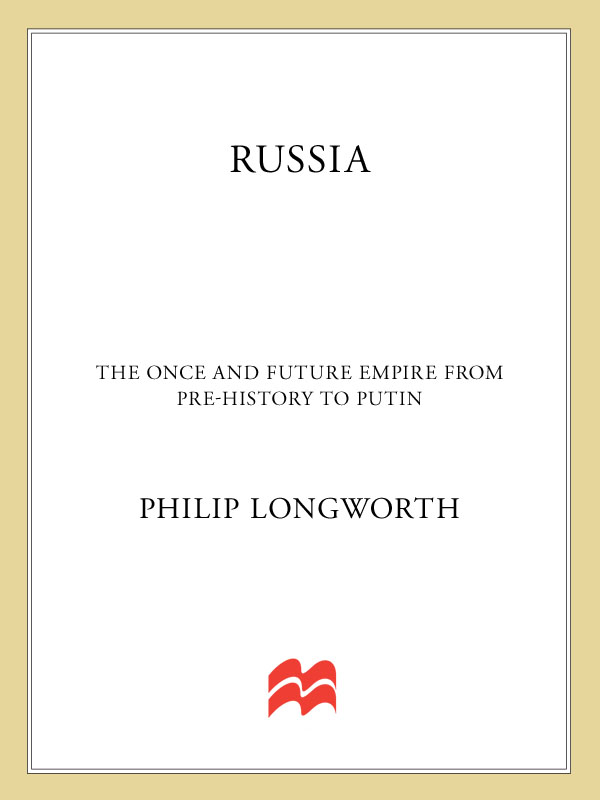
T
hrough the centuries, Russia has swung sharply between successful expansionism, catastrophic collapse, and spectacular recovery. This illuminating history traces these dramatic cycles of boom and bust from the late Neolithic age to Ivan the Terrible, and from the height of Communism to the truncated Russia of today.
Philip Longworth explores the dynamics of Russia’s past through time and space, from the nameless adventurers who first penetrated this vast, inhospitable terrain to a cast of dynamic characters that includes Ivan the Terrible, Catherine the Great, and Stalin. His narrative takes in the magnificent, historic cities of Kiev, Moscow, and St. Petersburg; it stretches to Alaska in the east, to the Black Sea and the Ottoman Empire to the south, to the Baltic in the west and to Archangel and the Arctic Ocean to the north.
Who are the Russians and what is the source of their imperialistic culture? Why was Russia so driven to colonize and conquer? From Kievan Rus’ —the first-ever Russian state, which collapsed with the invasion of the Mongols in the thirteenth century—to ruthless Muscovy, the Russian Empire of the eighteenth century and finally the Soviet period, this groundbreaking study analyzes the growth and dissolution of each vast empire as it gives way to the next.
Refreshing in its insight and drawing on a vast range of scholarship, this book also explicitly addresses the question of what the future holds for Russia and her neighbors, and asks whether her sphere of influence is growing.
PHILIP LONGWORTH
is the author of seven books including
The Cossacks
and
The Making of Eastern Europe.
He was educated by the army and at the University of Oxford and was professor of history at McGill University in Canada for nearly twenty years. He lives in north London.
The Art of Victory
The Unending Vigil
The Cossacks
The Three Empresses
The Rise and Fall of Venice
Alexis, Tsar of All the Russias
The Making of Eastern Europe
R U S S I A
The once and future empire from
pre-history to Putin
PHILIP LONGWORTH
St. Martin’s Press New York
New York
RUSSIA.
Copyright © 2005 by Philip Longworth. All rights reserved. Printed in the United States of America. No part of this book may be used or reproduced in any manner whatsoever without written permission except in the case of brief quotations embodied in critical articles or reviews. For information, address St. Martin’s Press, 175 Fifth Avenue, New York, N.Y 10010.
Library of Congress Cataloging-in-Publication Data
Longworth, Philip, 1933-
Russia : the once and future empire from pre-history to Putin / Philip Longworth.
p. cm.
Inlcudes bibliographical references and index.
ISBN-13: 978-0-312-36041-2
ISBN-10: 0-312-36041-X
1. Russia—History. 2. Soviet Union—History. Russia (Federation)—History.
I. Title.
DK40.L66 2006
947—dc22
2006048494
First published in Great Britain by John Murray (Publishers), a division of Hodder Headline, under the title
Russia’s Empires: Their Rise and Fall: From Prehistory to Putin
First U.S. Edition: December 2006
10 9 8 7 6 5 4 3 2 1
1. The Russians: Who are They?
4. The Foundation of an Empire
5. Ivan IV and the First Imperial Expansion
8. Peter the Great and the Breakthrough to the West
10. The Romantic Age of Empire
12. The Construction of a Juggernaut
13. The High Tide of Soviet Imperialism
14. Autopsy on a Deceased Empire
1. Saints Boris and Gleb: their martyrdom in 1015 was used to legitimate the Grand Princes of Kiev
2. Fresco of Emperor Constantine VII receiving Princess Olga at his palace in Constantinople,
c.
955-7
3. Model of the St Sophia Cathedral, Kiev
4. Miniature of the construction of Moscow’s Kremlin, 1491
5. Ivan III
6. Sixteenth-century Russian cavalryman
7. Punishments for recalcitrant natives
8. Reindeer-power in Okhotsk
9. Ceremonial show of force to greet the submission of an important chief
10. Nineteenth-century lithograph of Tiflis
11. The Darial Pass
12. A Tatar encampment
13. A Yakut shaman treating a patient
14. Kalmyks
15. A Russian embassy approaches the Great Wall of China, 1693
16. A Lapp shaman’s view of the world
17. SS
Peter and Paul,
Kamchatka
18. Bashkirs
19. An Estonian girl
20. An Ostiak ermine-hunter
21. A Chukchi in armour with his family
22. A Mordvinian woman
23. Circassian princes arriving for a conference, 1836
24. Persians paying Russian representatives an indemnity in bullion
25. Barracks for Gulag prisoners cutting the White Sea-Baltic Canal, 1933
26. In celebration of the completion of the Dnieper Dam
27. Completing the furnaces for the Soviet Union’s largest steel plant
28. President Putin brandishing a model of the
Molnia
spacecraft
The author and publishers would like to thank the following for permission to reproduce illustrations: Plate 7, From the Hakluyt Society’s
Yerrnark’s Campaign in Siberia,
ed. Terence Armstrong, London, 1975, reproduced by permission of David Higham Associates; 16, Add. 5523 fol.7, the British Library; 24, Laurence Kelly; 28, Getty Images, AFP/Maxim Marmur. Plates are also taken from the following publications: 2, S. Vysotskii,
Svetskie freski Sofuskogo Sobore v Kieve [Secular Frescos in the St Sophia Cathedral in Kiev],
Kiev, 1989; 3, I. Toskaia et al.,
The State Architectural and Historical Museum of St Sophia Cathedral,
2nd edn, Kiev 1996.
This book owes much to many helpers, but I alone am responsible for any errors it contains. I am grateful to former colleagues in three faculties of McGill University for advice in areas in which I lack expertise, and to the Department of History for granting me writing leave in the winter term of 2003. My debts to scholars in both Russia and the West go back many years, and are to some extent acknowledged in the references. I have also benefited from discussions with colleagues in the British Universities’ Association of Slavists’ Study groups on medieval and eighteenth-century Russia, the University of Budapest’s biennial seminar on Russian history, and the Royal Institute of International Affairs in London. McGill’s McLennan Library has a rich collection in the Russian area, and when it lacked an item I needed it readily obtained it for me. I am also grateful to the British Library and to the library of the School of Slavonic Studies in University College, London.
I am indebted to Bill Hamilton for the idea, to my conscientious and perceptive editor Gordon Wise, to Catherine Benwell and other members of the helpful John Murray team who saw the book through to its finished form, and, as always, to Ruth for her patience, encouragement and the critical eye which she applied to the entire text.
Philip Longworth
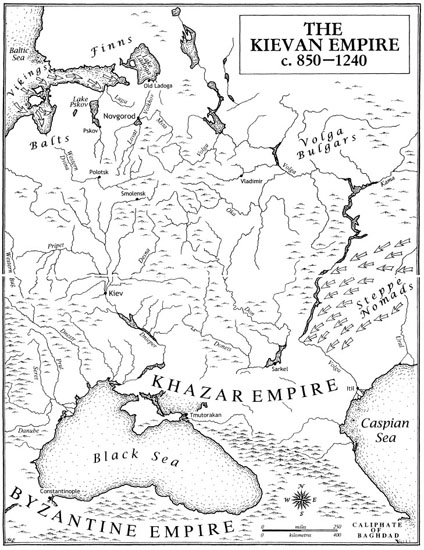
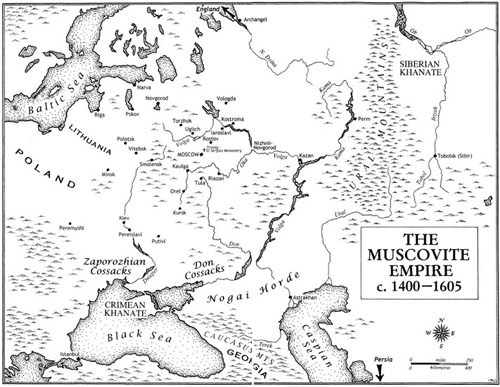
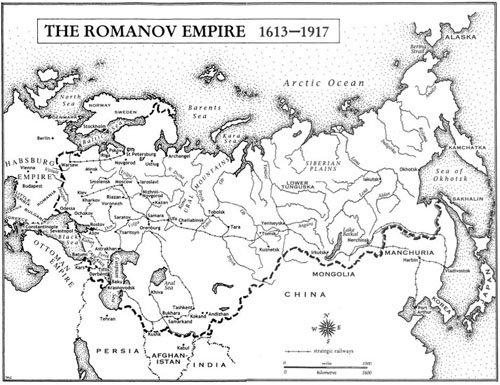
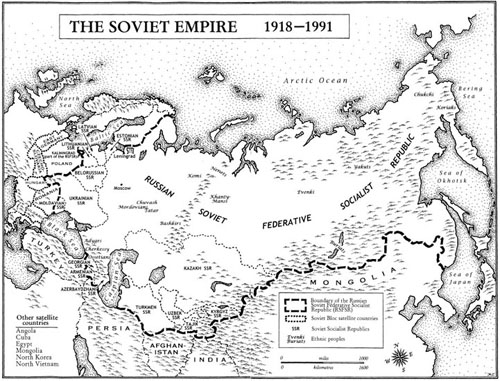
M
OST EMPIRES RISE,
expand and then collapse - and once collapsed do not revive. But Russia’s case is different. Russians have built no fewer than four empires. The first, the medieval commercial colonial empire of Kievan Rus, was destroyed in the 1200s. But some time later a new absolutist
imperium,
which tried to replicate something of the glory of the later Roman Empire, arose. It was centred on Moscow, the ‘Third Rome’ of legend. In the later sixteenth century, under Ivan the Terrible, it began to expand vigorously towards the Baltic, the Caspian and, across the Urals into Asia. Then, in the early 1600s, the state which was the motor of this empire suddenly seized up; Russia dissolved into confusion, and the neighbouring Poles were able to install their own tsar in the Kremlin. Yet out of the debris of Russia’s imperial collapse a third, more conventional, European dynastic empire soon emerged, rooting itself in the remains of its predecessor.
This Romanov Empire came to serve as the epitome of Russia’s power and aggression. It expanded into Ukraine, extended its hold on Siberia as far as the Pacific and the gates of China, and, having humbled Poland-Lithuania, proceeded to demolish the two great powers which dared to challenge it: Sweden and Napoleonic France. Having established itself as the strongest land power in Europe, it continued its expansion — through the Balkans towards the Mediterranean, across the Caucasus, and, to the consternation of the British, into the heights of Central Asia. It became a sea power to reckon with in the north Pacific, and even came to exert a certain influence in China. The Romanov Empire suffered reverses in the Crimean War and against Japan in 1904, though it lost little territory and influence as a result. Soon afterwards, however, during the First World War, this empire, too, disintegrated.
The Soviet state which supplanted it seemed unlikely to survive. Russia was racked by civil war, and was promptly invaded by British, French, Japanese and American troops. It lost a war with Poland too. Bankrupt, friendless and besieged, it nevertheless contrived, within the remarkably short span of a quarter of a century, to recover sufficiently to inflict a
comprehensive defeat on Hitler’s Germany, Europe’s strongest military and economic power, together with its allies, and to dictate the shape of post-Second World War Europe. This Soviet Empire - more centralized and ideological than any of its predecessors — became the most extensive and powerful of all. It was also the most short-lived.
The purpose of the book is to examine the phoenix-like nature of Russian imperialism and improve our understanding of it. Why the strange alternation between aggression and fragility? Why the tendency for Russian empires to disintegrate as they did around the years 1240, 1600 and 1918, but then to rise from the ashes stronger than before? Why, for that matter, do Russians, as a society, tend to alternate between torpor and manic energy, and what are the sources of their resilience? What has enabled them to withstand invasions by numerically and technologically superior armies; to spring back and gain the strength to conquer immense tracts of territory and exercise dominion over millions of subjects of diverse cultures?
To find adequate explanations for these phenomena we need to describe the rise and fall of each Russian empire and inquire into its strengths and weaknesses. But we also have to delve back to times before the modern era which most general histories treat either cursorily or not at all,
1
for it is only there that we can hope to find evidence that might illuminate some basic questions concerning the character of Russians: their psyche, habits and the singularities of their institutions, all of which were formed over time and in relation to physical conditions. And here we encounter a problem, because the early chronicles were composed to sustain the legitimacy and claims of princes rather than to provide objective records of circumstances and events. Nor are the earliest travellers’ accounts always reliable. Furthermore, such accounts begin too late in time. Since, as we shall see, there are good, scientific, reasons to believe that the Russians’ ancestors were explorers and colonizers for some time before the fabled founding father Riurik and his band of Viking venturers ever established themselves in their land, a way must be found of establishing relevant developments in periods unrecorded by conventional history.
To trace the origins of Russian imperialism, then, we need a wider range of tools than is offered by conventional history. The first chapter of this book will therefore exploit the findings of non-historical science — genetics, anthropology, archaeology and linguistics - to explore the roots of the phenomenon: the making of the landscape which formed the Russians’ habitat, their diet, physiognomy, migratory patterns, habits,
capacities and disposition. Readers should discover that some of these findings will resonate from time to time throughout the book. However, those who prefer conventional history should start with Chapter 2 (where for their benefit I have repeated a few essential points made in Chapter 1).
Some new material appears in later chapters, though they are mostly based on the work of specialist historians who are acknowledged in the endnotes. There is no shortage of general books on Russia and Russian imperialism, of course, and each one represents a view. But this book differs from all of them in its perspectives. It examines the formative stages in the development of the land and its people which took place
before
the era of written record to which historians generally confine themselves. Some of the material it uses is new, and confronts some popular prejudices which are based on outdated readings of the evidence or which obscure the truth. No doubt I have made mistakes, but my conclusions have been based on evidence rather than preconceived ideas, whether pro- or anti-Russian.
Chapter 2 describes the rise and fall of Kievan Rus. The three that follow consider the rise of Muscovy, its attainment of imperial status under Ivan the Terrible (who adopted the insignia of the double-headed eagle from the defunct Roman Empire) and its subsequent collapse. The next group of chapters deal with the new imperial expansion under the Romanov rulers Alexis, Peter the Great and Catherine the Great — an advance that was slow at first, but which, despite fierce resistance, gained steadily in tempo. They also describe the apogee of Romanov power which followed the Napoleonic Wars, the first great and bloody campaigns against the Chechens and Circassians in the Caucasus — wars which inspired some great romantic and imperialistic literature — and the subsequent decline and collapse in 1917—18.
The last set of chapters traces the astonishing rise of Soviet Russia, the burgeoning of its empire following the defeat of Nazi Germany, and its no less astonishing and precipitous collapse. Chapter 15 describes post-Communist Russia, while the Conclusion summarizes the results of the inquiry and also assesses Russia’s place and prospects in the world in 2004.